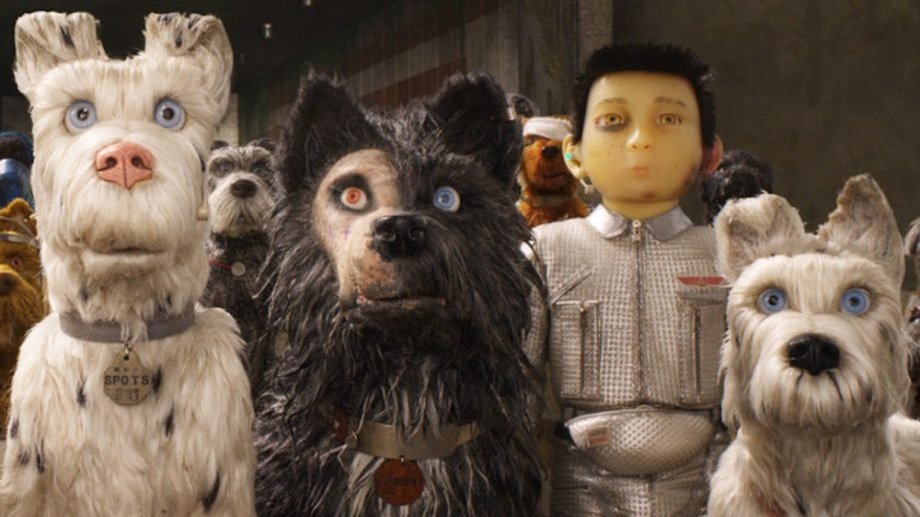Wes Anderson is one of the most iconic visual stylists working in film today. Known for his exactingly specific shot composition and hyper-detailed sets and costuming, when it was announced that his next film, this year’s Isle Of Dogs, would be a stop-motion animation film set in a dystopian future Japan — the spiritual home of hyper detailed aesthetics — it seemed like a match made in heaven.
The film follows the story of Atari (Koyu Rankin), an orphan boy who travels to the titular isle to rescue his dog Spots (Liev Schrieber) after his distant uncle and guardian, the dog hating Mayor Kobayashi (Kunichi Nomura), deports him as part of a plot to destroy all the dogs of the fictional city of Megasaki. Crash landing on the island, Atari is then discovered by a pack of dogs who decide to help him in his quest, the pack made up of motley crew of canine deportees including; Chief (Bryan Cranston) a stray dog who doesn’t believe in masters, Rex (Edward Norton) a master loving good boy, former dog snack model King (Bob Balaban), gossip loving Duke (Jeff Goldblum) and Boss (Bill Murray) who provides comic relief – and rounds out Anderson’s Bill Murray quota for the film. Serial Anderson cast member Angelica Huston also pops up in a credited yet silent role as Mute Poodle.
Like all Anderson’s work, Isle Of Dogs is a visual delight, and perhaps the most Wes Anderson of Wes Anderson films to date. Adam Stockhausen and Paul Harrod’s charming production and design is beautifully captured by cinematographer Tristan Oliver, the stunning set and character models framed in gorgeous wide screen compositions. This gives the film a cinematic quality larger than any of Anderson’s previous work. Ironic, considering it’s all shot using miniatures.
The story is also pure distilled Wes Anderson charm – an innocent child struggling against unjust adults in the name of love and friendship – and the name is even a pun on I love dogs. So you might therefore assume the film would be immune from controversy. Perhaps Anderson thought so too, until the accusations of cultural appropriation started flying that is.
Kicking off following Justin Chang’s review in the L.A. Times, social media and other critics soon emerged accusing Anderson of “using Japanese culture as a prop” and decrying the “willfully tone-deaf ways… [he]… appropriates and marginalizes Japanese culture.”
Now these accusations certainly aren’t baseless. Anderson clearly relishes in referencing/appropriating Japanese culture, with the film giving nods to everything from Akira Kurosawa to screen painting and sumo wrestling. The soundtrack by Alexandre Desplat also gets in on the plunder, for the most part made up of spare and dramatic taiko drums with the odd classic pop song flourish you’d expect from Anderson slipped in for good measure.
Aside from the film’s visual appropriation/appreciation of Japanese culture, one of the most problematic aspects of the film raised by Chang and others was the director’s choice to have the dogs speak English while the human characters – who are mainly Japanese – speak in their native tongue without subtitles.
Anderson explains this from the start with a title card telling us; “The humans in this film speak only in their native tongue (occasionally translated by bilingual interpreter, foreign exchange student, and electronic device). The dogs’ barks are translated into English.”
For non-Japanese speakers then, a lot of what the Japanese characters say is quite literally lost in translation. As Chang describes it, “much of the Japanese dialogue, especially Atari’s, has been pared down to simple statements that non-speakers can figure out based on context and facial expressions,” with the more complicated passages retold through the aforementioned translators.
This then understandably led a lot of non-Japanese speakers to accuse Anderson of literally taking the voices away from his Japanese characters, all the while indulging in his favourite pastime of plundering different cultures, eras and aesthetic traditions to his own creative ends. Anderson of course plays up the Japanese cultural elements a lot, and at times it does feel like a white man-child’s fantasy vision of the nation… because it is.
But, as Chang also notes, this is true of all of Anderson’s films. In fact isn’t his ability to take the rough edges off reality and invite us inside his imagination – what Chang refers to as “Wes Anderson Land” – why we love his films so much in the first place?
Anderson’s Japan is his latest dolls house re-imagining of place, which like any miniature takes the most recognisable aspects and breaks them down to their simplest parts to avoid having the general aspect get lost in the details. It’s problematic to be sure, but judging things based purely on how it all looks, it’s hard not to delight in the stunning visuals.
On a purely aesthetic level, Japan as a culture and a nation is in many ways the ideal canvas for Anderson to play out his carefully constructed and fanatically specific game of make believe. The shots of sushi being prepared in particular stand out as a no brainer Andersonism, begging the question of how the director hasn’t already made a film about a disaffected sushi chef, his estranged son and the woman they both love.
Putting the visuals aside, the lack of subtitles did affect my first watching. As a non-Japanese speaker, I found it difficult to engage emotionally with the Japanese characters, and felt that as such Anderson was merely using them as background set dressing for the dogs’ story. Yet after reading Moeko Fujii’s comment on the film for The New Yorker, I reconsidered my take.
As Fujii – a Japanese-speaker – explains in the article, to assume that these characters are dehumanised by Anderson’s withholding of subtitles “assumes the primacy of an English-speaking audience”. Viewed through the eyes – or should I say ears – of a Japanese speaker she argues, the film takes on new layers of meaning, and new depths of cultural sensitivity.
The film is full of nuanced and accurate representation of Japanese culture and language. From how a news anchor segues between stories – “This is the next news” – to the labelling of elementary school milk cartons with “extra thick” Anderson’s hyper detail oriented eye offers a degree of cultural specificity lacking in most other Western representations of Japan.
More than just allowing for such moments of cultural homage, Anderson’s choice not to use subtitles and instead rely on on-screen translation draws attention to the act of translation itself. As the film’s numerous translators – human, electronic or otherwise – often miss the finer details and cultural nuance of the characters’ speech, Anderson is in a way emphasising his own act of translation, in essence admitting that huge parts of Japanese culture will be lost as he translates it into film via his own idiosyncratic style.
This doesn’t mean the film is without its problems, but as Chang himself was quick to point out following the explosion of outrage on social media, his review was “a mixed, measured appraisal” and not a condemnation. He posed questions, rather than make accusations. Specifically he asked if this “white American filmmaker’s highly selective, idiosyncratic rendering of an East Asian society constitute[s] a sincere act of homage, or a clueless failure of sensitivity?”
Now as a white Australian film critic I don’t think I am at all qualified to answer this question, but what seems clear to me is that Anderson wasn’t ignoring the issue while making the film. Instead seems to be directly engaging with it in a way not many filmmakers do.
Having added such layers of meaning to a film that on the surface is a rather simple story about a boy looking for his lost dog, Anderson is perhaps posing his own question about how we define the line between cultural appreciation and appropriation. Whatever side of the line his film falls on, one has to admire the imagination with which he frames the question, as well as the surprising, charming and enjoyable movie he has made while doing so.
–
‘Isle Of Dogs’ is out in cinemas, now.














